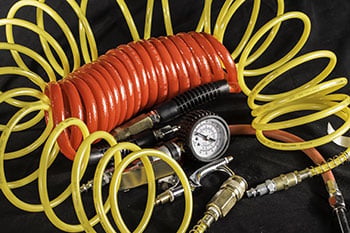ACFM vs. SCFM (Actual Cubic Feet/Min. vs. Standard Cubic Feet/Min.)
The air compressor industry loves to use acronyms, especially when measuring airflow and air consumption. Two common acronyms that represent airflow measurements are ACFM and SCFM.
But before jumping into those, we need first to understand a more basic acronym: CFM. CFM, or Cubic Feet per Minute, is a general measurement for the volume of air that comes out of a compressor.
All air tools and equipment require a specific minimum air supply to perform properly, so an air compressor must provide the necessary CFM to meet that need. Therefore, CFM is a critical metric when choosing an air compressor.
For example, a 1” impact wrench that requires 45 CFM of air must pair with an air compressor that produces at least 45 CFM for the entire time that impact wrench is used. If the compressor can’t provide or maintain that air volume, the impact wrench will lose its turning power and may stop working entirely.
But what does it mean when manufacturers use ACFM or SCFM to rate their air compressors’ output instead of CFM? Read on…
What is ACFM?

Actual Cubic Feet per Minute, or ACFM, has different definitions depending on the industry. As an air compressor manufacturer, VMAC defines ACFM as the true air mass flow given during a particular set of real-life conditions. We will simulate a real-life environment and then measure the CFM based on the actual output of air in that environment, resulting in ACFM.
But ACFM can be tricky. It is impacted by atmospheric conditions and the surrounding environments, which means ACFM can vary between locations. For example, an air compressor on a mountaintop is likely to have a lower output than that same air compressor at sea level.
You can read more about how altitude and environment impact air compressor performance in this article: Why Does My Air Compressor Perform Differently At High Altitudes?
What is SCFM?
SCFM (Standard Cubic Feet per Minute) measures air output, like ACFM, but uses a standard that takes atmospheric conditions into account.
SCFM is a set of specific parameters determined by the American Society of Mechanical Engineers (ASME), which are recognized across many industries. These SCFM calculations are based on atmospheric conditions (“standard conditions”) to measure air mass flow from an air compressor.
SCFM “standard conditions” include:
- Atmospheric pressure at sea level of 14.7 PSIA (760 mmHg),
- Relative humidity of 36%, and
- Ambient temperature of 68°F (19°C).
After completing the calculations using these conditions, the maximum SCFM output of the air compressor is revealed.
SCFM is the only way to compare “apples to apples” or air compressor to air compressor. Operating conditions may vary depending on where the air compressor air flow is being measured. However, it’s important to note that your real-world ACFM output may not match the SCFM if you work in conditions that don’t align with the standard ones.
Differences Between ACFM & SCFM

At “standard conditions,” with no efficiency losses, SCFM equals ACFM. Where inlet conditions vary from standard conditions, you may need to consider whether your air compressor still provides enough air for your tools and equipment to perform properly on the job site.
ACFM demand by a tool may be higher if any one of the following conditions is different from standard conditions:
- atmospheric pressure is lower (elevation is higher)
- humidity is higher
- temperature is higher
Another way of thinking about this is that the air compressor needs to work harder as the job site shifts away from “standard conditions.” A more powerful air compressor with a higher SCFM rating may be required to generate adequate ACFM for the air tool to perform correctly on the job site.
Quick Calculations:
- For every 1000 ft (305 m) of elevation increase over “standard conditions”, ACFM demand increases by approximately 5%.
- For every 20oF (11.1oC) of ambient temperature increase over “standard conditions”, ACFM demand increases by approximately 5%.
- For every 20% humidity increase over “standard conditions”, ACFM demand increases by approximately .5%.
Example Calculation:
A 1” impact gun may have a minimum air mass flow requirement of 45 CFM. On the job site in Fort McMurray, Alberta, at an elevation of 1,211 ft (369 m) on June 22, 2026, at 2:00 pm, atmospheric pressure is 14.2 PSIA (732 mmHg), humidity is 24%, and temperature is 84°F (27°C). For an air compressor to generate 45 ACFM in these conditions, it needs an SCFM rating of approximately 49 SCFM.
Why Does ACFM vs. SCFM Matter?
You need to ensure your air compressor system produces enough air to properly power your tools and equipment on your specific job site. If your work environment impacts air production, SCFM ratings may not perfectly reflect your real-world needs. Unless you only use your air compressor on the beach on a cool spring day, add a buffer when evaluating your compressed air needs!

